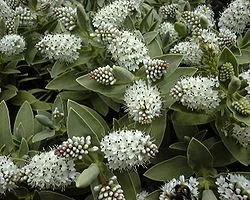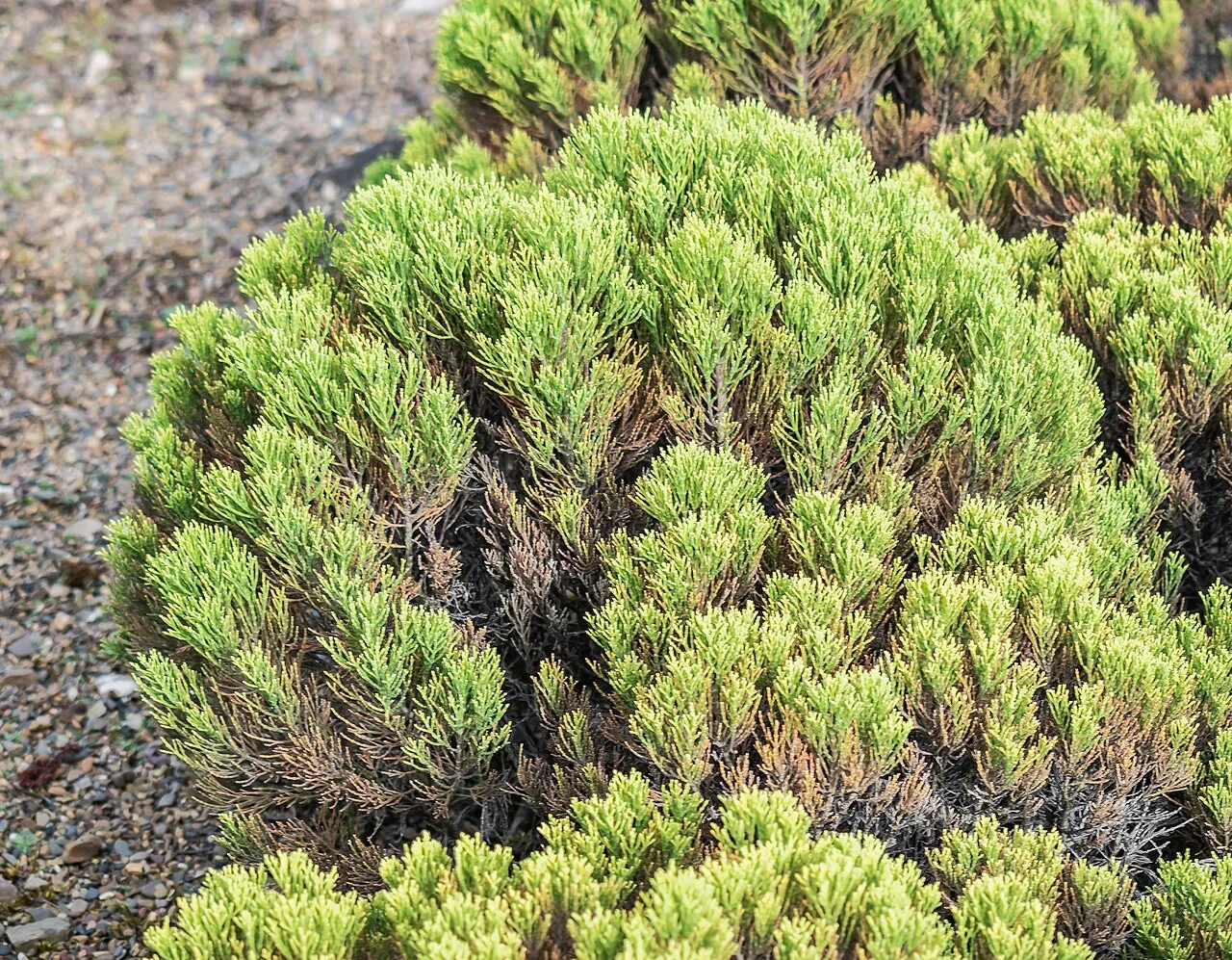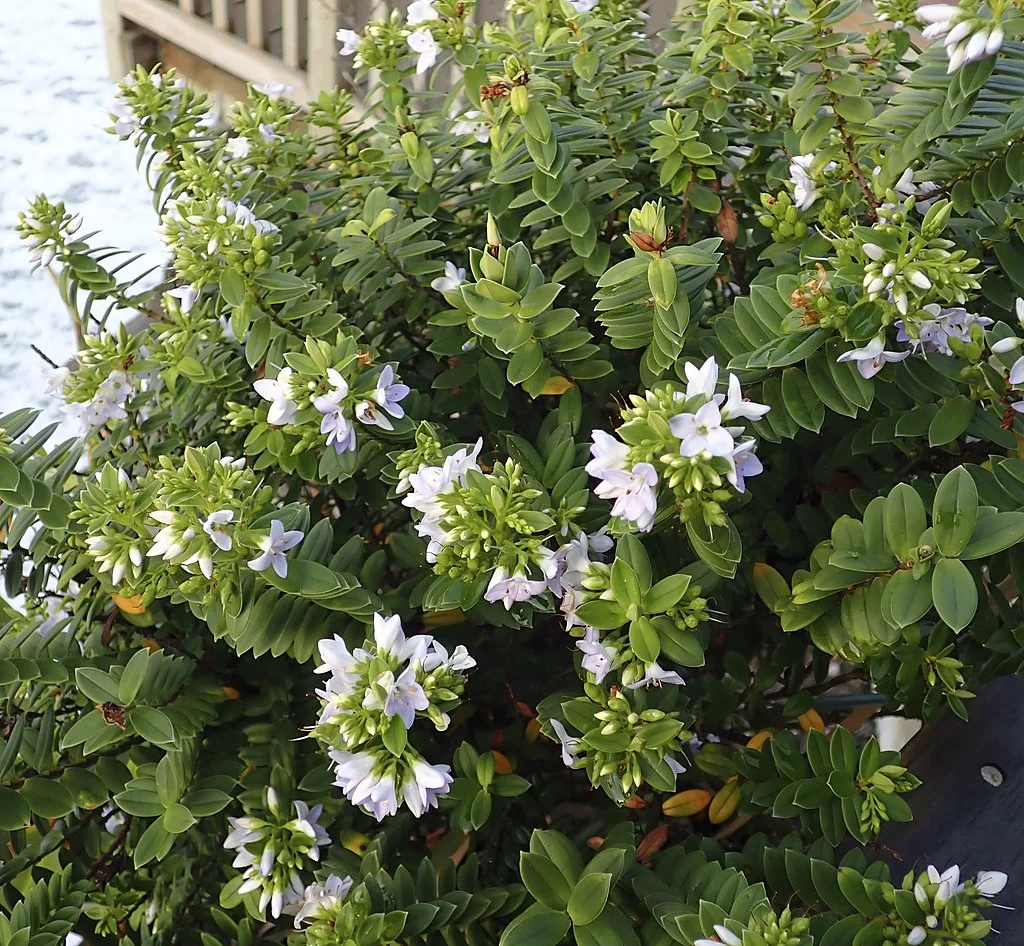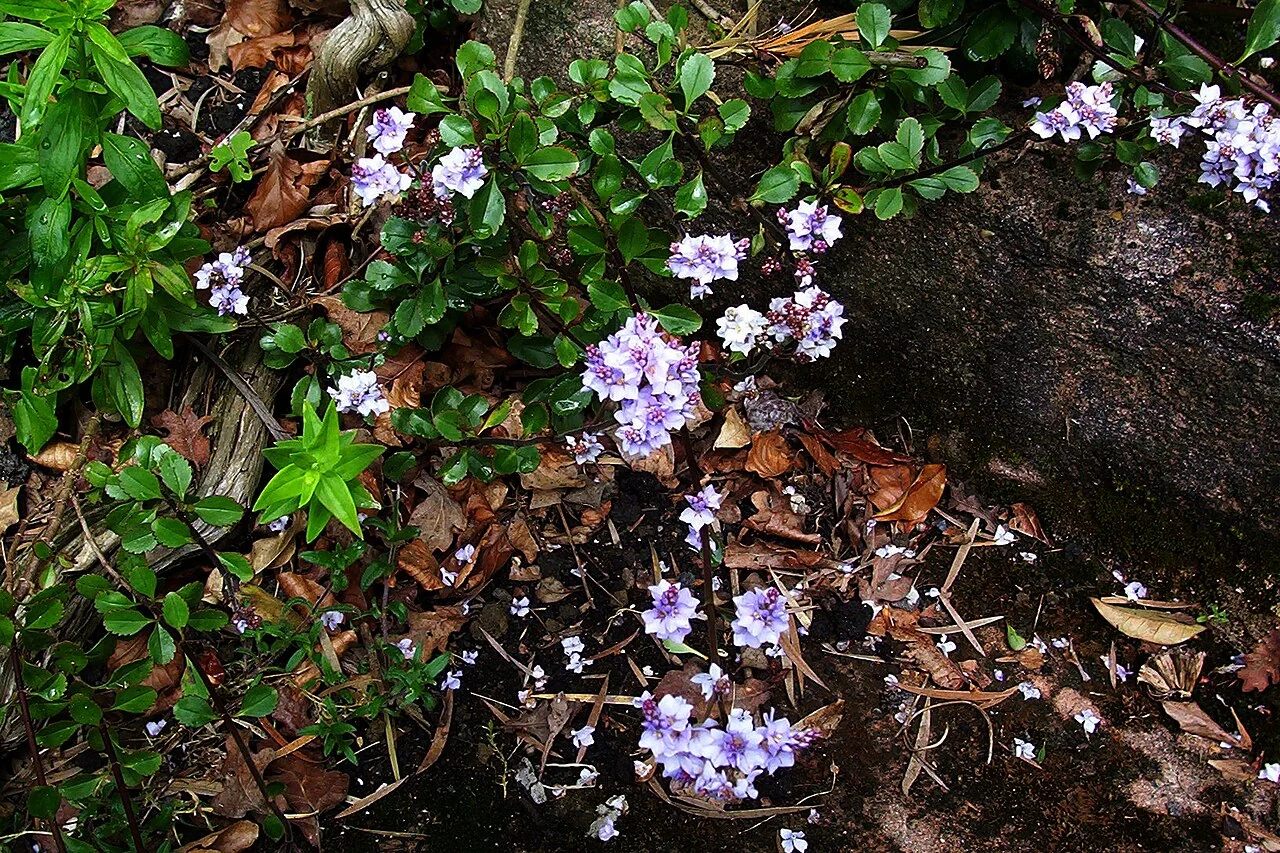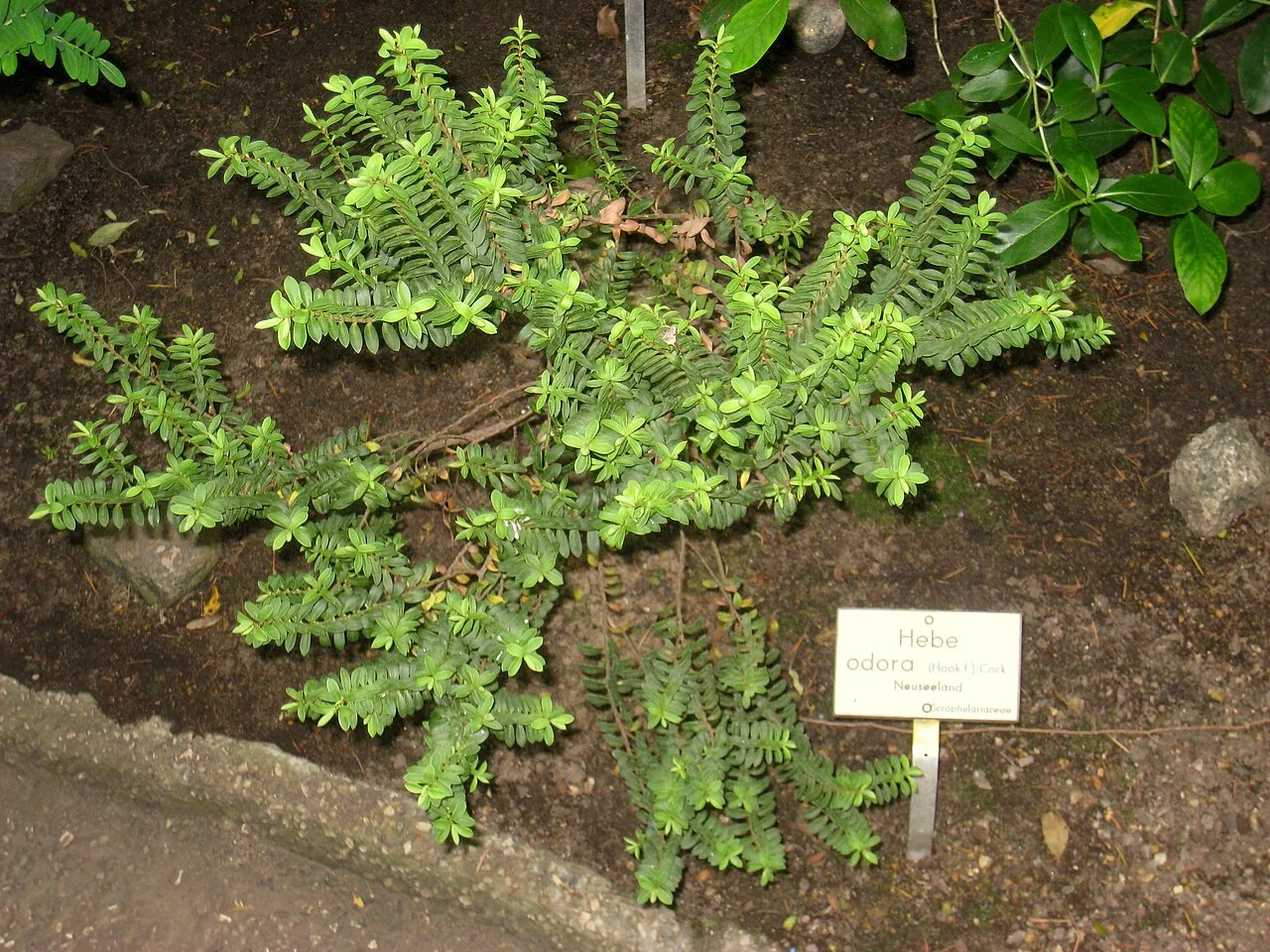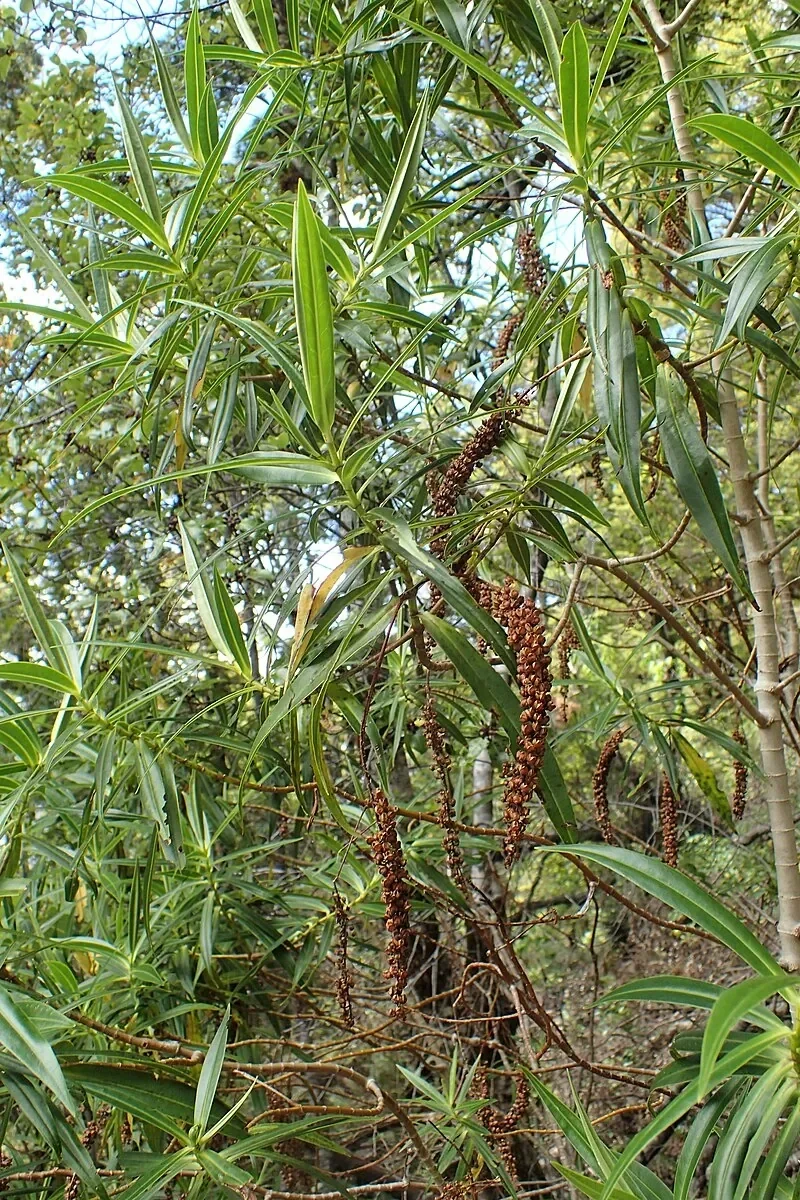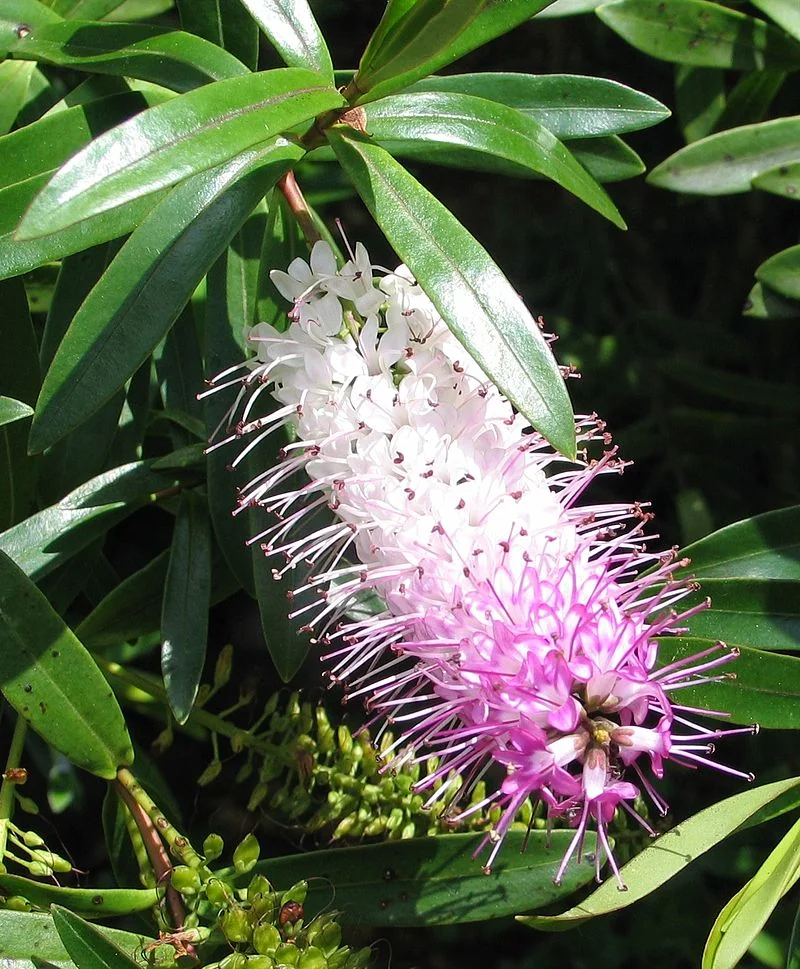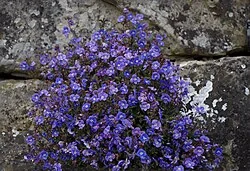
Bentham's Hebe
Veronica benthamii
Introduction
Introduction Overview
Veronica benthamii is a compact hebe (0.6-1.2 m) with tidy branching and showy summer flower spikes. It prefers free-draining soils and performs well in sunny borders and coastal gardens. native shrubs .

Plant Description
Botanical Features
Bentham's Hebe ( Veronica benthamii ) is a native and endemic vascular shrub found in New Zealand. It typically grows up to 1 meter tall and is characterized by its low-growing, bright green, bushy, and fleshy appearance. Its stems are decumbent or ascending, with eglandular-pubescent or glabrous (hairless) stems. The leaves are oval, coriaceous (leathery), ranging from 10-33 mm long and 3.5-14.5 mm wide. They are arranged in opposite-decussate pairs, are shortly connate (joined at the base), and often have bluntly toothed to crenate margins. A distinctive feature is a thick band of dense, tangled white hairs along the leaf margins, giving them a furry, silvery appearance. Small, blue to purplish flowers are borne in terminal racemes (spikes) that can be 30-80 mm long, sometimes up to 10 cm. The flowers typically have 4-6 calyx and corolla lobes. The capsules are latiseptate (2-locular) or trigonous/turgid (3-locular), acute or sub-acute, glabrous, and 4-8 mm long. The seeds are broadly ellipsoid to discoid, flattened, smooth, and straw-yellow to dark brown, measuring 1.2-1.9 mm long.
Quick Facts
Quick Facts Overview
| Scientific Name | Veronica Benthamii |
|---|---|
| Height | 0.6-1.2 m |
| Spread | 0.6-1.0 m |
| Water Needs | Moderate (free-draining soil) |
| Light | Full sun to partial shade |
| Frost Tolerance | Moderate |
| Salt Tolerance | Moderate; tolerates coastal conditions |
| Growth Rate | Moderate |
| Lifespan | Long-lived shrub |
Climate Best Suited to
Well adapted to lowland coastal to inland gardens with winter drainage. Performs best in regions with mild winters and not overly hot summers.
Regional Suitability
| Whangārei | Ideal |
| Auckland | Ideal |
| Hamilton | Suitable |
| Rotorua | Suitable |
| Tauranga | Ideal |
| Gisborne | Ideal |
| New Plymouth | Ideal |
| Whanganui | Ideal |
| Palmerston North | Suitable |
| Napier | Ideal |
| Wellington | Ideal |
| Nelson | Ideal |
| Christchurch | Suitable |
| Dunedin | Suitable |
| Invercargill | Suitable |
| City | Climate Suitability |
|---|
Natural Habitat
Bentham's Hebe ( Veronica benthamii ) is an indigenous and endemic vascular shrub found only in New Zealand, specifically on the Auckland Islands and Campbell Island/Motu Ihupuku.
Key Habitats Include:
- Sub-alpine Tussock Grassland and Low Scrub: Its natural habitat primarily consists of sub-alpine tussock grassland and low scrub, indicating its adaptation to exposed, high-altitude environments.
- Steep and Rocky Slopes: It is commonly found on steep and rocky slopes, often growing on peat amongst Chionochloa antarctica tussocks and shield fern ( Polystichum vestitium ). It can also be found around boulder and rock outcrops.
- Coastal to Montane Regions: Its habitat ranges from coastal to montane regions, with recorded elevations from 90 to 495 meters.
Preferred Conditions:
- Well-Drained Soil: It prefers free-draining soils and performs well in sunny borders and coastal gardens.
- Cooler Climates: It is well-adapted to cooler climates with mild winters and not overly hot summers.
The presence of Veronica benthamii in these specific subantarctic island habitats underscores its ecological importance in contributing to the unique biodiversity and structural complexity of New Zealand's remote island ecosystems.
Plant Conservation
Veronica benthamii , also known as Bentham's hebe, is a plant species endemic to New Zealand, specifically found on the Auckland Islands and Campbell Island/Motu Ihupuku. As of 2023, its conservation status is classified as "At Risk - Naturally Uncommon" with a "Range Restricted" qualifier. Despite this classification, there are currently no known threats to Veronica benthamii . The plant thrives in its natural habitats, which are protected within Nature Reserves and World Heritage Sites, with access regulated by the New Zealand Department of Conservation.
Growing Requirements
Soil
- Well-drained sandy or loamy soils
- Enrich with compost for structure
- Avoid heavy , waterlogged clays
Light
- Full sun promotes dense flowering
- Partial shade tolerated
- Shelter from cold, drying winds
Water
- Moderate watering ; reduce in winter
- Mulch to conserve moisture
- Do not allow prolonged wet feet
Planting Guide
When to Plant
Autumn or spring in most regions; avoid periods of extreme heat or cold.
Site Selection
- Sunny, sheltered position
- Free-draining soil
Ecological Role
Environmental Impact
Veronica play vital ecological roles as nectar sources for native insects, butterflies, and occasionally birds, with their abundant flowers providing food throughout much of the growing season. Many species serve as nurse plants in harsh environments, creating sheltered microsites that enable other native plants to establish. Their diverse growth forms from groundcovers to small trees fill numerous ecological niches in New Zealand's ecosystems.
Uses and Significance
Garden Uses
- Compact flowering shrub for borders
- Coastal gardens and mixed native plantings
- Low informal hedging
- Excellent for rock gardens and alpine displays.
Cultural Significance
Traditional Uses and Values
While specific cultural significance for Veronica benthamii is not widely documented, the genus name "Veronica" is thought to be derived from Saint Veronica, and the species epithet "benthamii" honors George Bentham, a prominent 19th-century botanist. Related Veronica species (formerly classified under Hebe ) hold cultural significance within New Zealand, particularly in Māori culture and traditional practices (Rongoā Māori). These plants are valued for their resilience and historical association with various regions, and some were even cultivated by Māori for their ornamental qualities, demonstrating advanced horticultural practices.
Landscaping Section
Landscaping Section Overview
This section provides important information about plant care and cultivation practices. Understanding these aspects helps ensure successful growth and development in garden conditions.
Seasonal Care Calendar
Spring
- Feed lightly with balanced fertiliser
- Tip-prune to shape if needed
Summer
- Main blooming period; deadhead lightly
- Water during extended dry spells
Autumn
- Reduce watering ; mulch for winter
Winter
- Ensure good drainage to prevent root issues
When to Prune and How Much
When to Prune and How Much Overview
Light annual pruning after flowering maintains a dense habit. Avoid hard pruning into old wood.
How to Grow Bentham's Hebe
Bentham's Hebe is a unique and attractive alpine shrub, but it is classified as "At Risk - Naturally Uncommon." This status means that the plant is not abundant in the wild, and its cultivation is not widespread. It is not commercially available, and it is crucial that this plant is not removed from its natural habitat. The information provided here is based on general knowledge of the Veronica genus and should be adapted with care, as Veronica benthamii has specific requirements that make it challenging to grow outside of its native environment.
From Cuttings
Propagating Bentham's Hebe is known to be difficult. While many Veronica species can be propagated from cuttings, this particular species has a low success rate. For those attempting propagation for conservation purposes, semi-hardwood cuttings taken in late summer would be the most likely method to yield results. The cuttings should be taken from healthy, non-flowering shoots and planted in a sterile, free-draining medium. Maintaining high humidity and providing bottom heat may increase the chances of success.
From Seed
Growing Bentham's Hebe from seed is also challenging, as the germination requirements for this specific species are not well-documented. Any attempt at cultivation should be done with the goal of conservation, and with material from legitimate, non-wild sources. Seeds would likely require a period of cold stratification to break dormancy, and a sterile, free-draining seed-raising mix would be essential. Due to the rarity of this species, seed propagation is generally left to experienced botanists and conservation nurseries.
Pests and Diseases
Pests and Diseases Overview
Generally trouble -free when well-drained. Monitor for scale and aphids; maintain airflow.
This section provides important information about plant care and cultivation practices. Understanding these aspects helps ensure successful growth and development in garden conditions.
Bonus Tip
Veronica benthamii , or Bentham's Hebe, is notable for its unique appearance, featuring bluntly toothed leaves edged with a thick band of tangled white hairs. Despite its restricted native range to New Zealand's subantarctic Auckland and Campbell Islands, it is classified as 'At Risk - Naturally Uncommon' but faces no known threats, thriving abundantly in its protected habitats.
